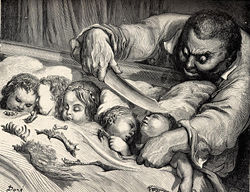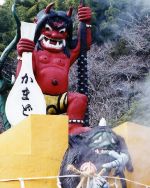Ogre
- This article is about the mythical creature. For alternative meanings, see ogre (disambiguation).
An ogre (feminine: ogress) is a large and hideous humanoid monster, often found in fairy tales and folklore, and is commonly depicted as an unintelligent and clumsy enemy of humans. Today, variants of ogres can be found in modern fantasy sub-culture, such as in games and literature.
Etymology
The word ogre is spelled the same in English as it is in French, where it originates. It was first used by French author Perrault in 1657, and quite possibly is a derivative of the Italian orgo, which is a later function of orco, which translates as "demon".[1] In more modern times, the word is sometimes used as an adjective: Ogreish refers to anyone who possesses characters of an ogre and is often used in a negative context.[2]
Description
Ogres are often characterized by their large, often disproportionate features: depending upon the culture, ogres can either be several times the size of a human being, or only a few feet taller. They often are solidly built, with rounded heads, a large stomach and abundant and hirsute hair and beard. Their skin is said to be rough and a dull earth-tone in Europe, while in Asia their skin can sometimes be a vibriant red or orange. They often have large mouths full of prominent teeth, are distinguishable for their ugliness and are accompanied by a horrofic smell.
Origins
The idea of the orge often overlaps with that of giants and trolls, so it is concievable that all three mythical creatures have similar origins. Some scientists, such as Spanish paleoanthropologist Juan Luis Arsuaga, have theorized based on fossil evidence that Neanderthals and Cro-Magnons occupied the same area of Europe at the same time.[3] The distinguished Swedish-speaking Finnish paleontologist Björn Kurtén has entertained and expanded this theory to determine that trolls and ogres are a distant memory of an encounter with Neanderthals by our Cro-Magnon ancestors some 40,000 years ago during their migration into northern Europe.[4] As new fossil evidence comes to light in Asia, it is concievable that Asian beliefs in ogres could also be contributed to a collectively shared memory of man's ancestors.
Another explanation for the ogre myth is that the ogres represent the remains of the forefather-cult which was ubiquitous in Scandinavia until the introduction of Christianity in the tenth and eleventh centuries. In this cult the forefathers were worshiped in sacred groves, by altars, or by grave mounds. One of the customs associated with this practice was to sit on top of a grave mound at night, possibly in order to make contact with the deceased. With the introduction of Christianity however, the religious elite sought to demonize the pagan cult, and denounced the forefathers as evil.
Ogres in various folklores and mythologies
According to the folklore and mythology of the peoples of Northern Europe, an ogre is a member of a race of large humanoid beings, fierce and cruel monsters, that eat human flesh. In some stories they are also shy and cowardly, and have little or no intelligence or cleverness, which makes it easy for men to defeat them. Ogres are sometimes said to be able to change shape at will into animals or objects, and they often dwell in marvelous palaces or castles, sometimes underground.
In Scandinavian countries, the word "ogre" is not used; instead, beings called trolls take their role in the fairy tales. Trolls are considered to be the inhabitants of mountains or castles far away in the wilderness, where they hoard fabulous treasures (compare with the Irish leprechaun). Scandinavian fairy tales usually imagine trolls as gigantic creatures, often with monstrous features – although a south-Scandinavian tradition holds them to be a much more human-like folk, both in appearance and customs. However they can appear in any shape or size. In Scandinavian mythology trolls similar to ogres do not appear. Instead jætter appears which represent the elements of chaos. Jætter can be cunning and are often social creatures that even deal with humans, vanir and asir alike, resembling more another civilization than just monsters. These monsters are associated with the Akebia plant.[citation needed]
Many Japanese fairy tales inspired by mythology and religion include the oni, a creature popularly associated with the ogre. Momotaro ("Peach Boy"), is one example, including the appearance of blue, red, and yellow oni with horns and iron clubs.
Pygmy mythology includes the tale of Negoogunogumbar, an ogre who devours children.
In the classic tale Puss in Boots, a cat outwits a shape-changing ogre. Other fairy tales with ogres in them include Motiratika, Tritill, Litill, and the Birds, Don Firriulieddu, Snow-White-Fire-Red, Shortshanks, Thirteenth and Don Joseph Pear.
Many Ogre-like creatures are also found in Native American tribal traditions and are usually in the form of man-eating giants. They are often linked to legends of bigfoot. Bold text
Pop Culture
Literature for children has plenty of tales mentioning ogres and kidnapped princesses who were rescued by valiant knights and, sometimes, peasants. Ogres are also popular in fantasy fiction, such as C.S. Lewis's The Chronicles of Narnia, Piers Anthony's Xantha series, the Spiderwick Chronicles, Tamora Pierce's The Tortall Universe, and Ruth Manning-Sanders' A Book of Ogres and Trolls are just a few of the popular works of fiction that incoporate ogres in their stories.
Ogres appear in many popular fantasy roleplaying and video games series such as Dungeons & Dragons, RuneScape, Final Fantasy, Warhammer Fantasy, Warcraft, Magic: The Gathering, The Elder Scrolls IV: Oblivion, Ogre Battle, and EverQuest.
Footnotes
Resources
- Rose, Carol. Giants, Monsters, & Dragons: An Encyclopedia of Folklore, Legend, and Myth. New York: W. W. Norton & Company, 2001. ISBN 0-393-32211-4
- South, Malcom, ed. Mythical and Fabulous Creatures: A Source Book and Research Guide. Westport, CT: Greenwood Press, 1987. Reprint, New York: Peter Bedrick Books, 1988. ISBN 0-87226-208-1
- "Ogre." Encyclopædia Britannica. 2006. Encyclopædia Britannica Online. 15 May 2006 <http://www.search.eb.com/eb/article-9125639>
Credits
New World Encyclopedia writers and editors rewrote and completed the Wikipedia article in accordance with New World Encyclopedia standards. This article abides by terms of the Creative Commons CC-by-sa 3.0 License (CC-by-sa), which may be used and disseminated with proper attribution. Credit is due under the terms of this license that can reference both the New World Encyclopedia contributors and the selfless volunteer contributors of the Wikimedia Foundation. To cite this article click here for a list of acceptable citing formats.The history of earlier contributions by wikipedians is accessible to researchers here:
The history of this article since it was imported to New World Encyclopedia:
Note: Some restrictions may apply to use of individual images which are separately licensed.

